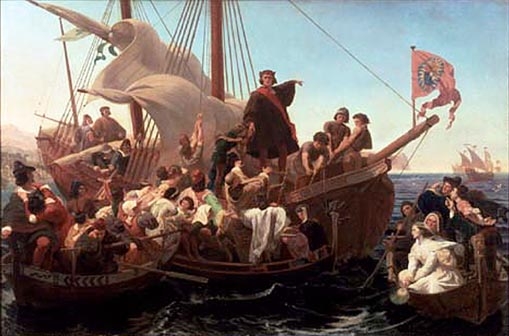
Columbus: The Four Voyages by Laurence Bergreen. Viking Press, New York.
*
Columbus Day is in trouble. Three of the United States do not observe it, and California is debating changing it to a celebration of America’s native tribes.
What’s the problem? Why the shift of tides against honoring the man?
First, let’s explore why October 12 became a holiday in the first place. Columbus Day was declared a federal holiday in the United States in 1937 largely because of a desire by Italian-Americans, at a time when Italy was allied with Nazi Germany, to affirm their connection with the USA and to celebrate an Italian who was a good guy as opposed to a Fascist friend of Hitler. President Franklin D. Roosevelt proclaimed Columbus Day a national holiday, largely as a result of intense lobbying by the Knights of Columbus, an influential Catholic fraternal organization.
Samuel Eliot Morison, the Harvard historian, was the most distinguished writer on Columbus, the author of a multivolume biography, and was himself a sailor who retraced Columbus’s route across the Atlantic. In his book Christopher Columbus, Mariner, written in 1954, he tells about the enslavement and killing of indigenous peoples: “The cruel policy initiated by Columbus and pursued by his successors resulted in complete genocide.”
Yet Morison summed up his view of Columbus on a positive note: He had his faults and his defects, but they were largely the defects of the qualities that made him great: his indomitable will, his superb faith in God and in his own mission as the Christ-bearer to lands beyond the seas, his stubborn persistence despite neglect, poverty and discouragement. But there was no flaw, no dark side to the most outstanding and essential of all his qualities— his seamanship.
Despite Morison’s contribution to historiography, his conclusion was troubling. Many 21st-century readers would welcome a new perspective. Fortunately, an alternative biography is available. Laurence Bergreen, the historian and biographer of Marco Polo, Ferdinand Magellan and others became enamored with exploration when writing Voyage to Mars: NASA’s Search for Life Beyond Earth in 2000. His approach to Columbus is critical, and Bergreen gives us a compelling picture of a flesh-and-blood man. Despite Columbus’s flaws, we come to admire the audacity of his high-pressure salesmanship and self-promotion.
For example, he was able to convince Spain’s Ferdinand and Isabella that a sea expedition to India was preferable to land routes that were fraught with danger from desert heat, sand storms and Muslims. Thus he was able to get royal permission to use the title Grand Admiral of the Ocean Sea and Viceroy and Perpetual Governor of all that I discover.
The enslaving of Native Americans doesn’t come as such a surprise when we realize that slavery was common in Genoa, where Columbus grew up, and where many non-Christian girls aged 13 or 14 were bought and sold for household servitude or as concubines.
Bergreen adds colorful details about Columbus’s background and the life on the islands. Morison’s book is stronger on navigational details, but Bergreen’s is a more exciting adventure story.
Columbus kept journals and so did his son. They described the topography and the botany in great detail. He reported very high and beautiful mountains, thick with high and leafy trees on what we now know as San Salvador and Cuba. He saw fish of the brightest colors in the world, blue, yellow, red.
Columbus’s men told the natives they had come from the sky and the so-called Indians were awed by that. Natives welcomed the Christian invaders into their homes where they fed them great carrots and potatoes and the cassava plant: They make bread of it, and cook and roast it, and it has the proper flavor of chestnuts. Passages like that give us a vivid picture of the continent.
Columbus sounds lascivious as he describes near-naked women, two wenches as white as they can be in Spain. At other times, Columbus’s thoughts are more lofty: The air was like April in Castile. At night some little birds sang sweetly. But he felt frustrated because he found less gold than he had anticipated. He had sold the Spanish rulers the idea of bringing great riches back to them.
Therefore, Columbus altered the tone of his letters and journals. Instead of gold, he wrote of importing slaves and converting them to our Holy Faith. He planned to present six of these naked individuals personally to his royal sponsors.
He was a tough boss. When some of his men attempted to commandeer a ship and sail back to Spain, Columbus harshly punished them by flogging, amputation of limbs or execution. Keep in mind that this was a cruel era; his patrons back in Spain simultaneously were in the midst of the Inquisition.
On his third trip, which lasted from 1498 to 1500, he went further south in a desperate search of gold. At the same time, Vasco de Gama found a sea route from Portugal to India by sailing east, not west as Columbus had done. Rival Spanish explorers also were venturing into the Caribbean. Clearly, Columbus’s importance was waning.
On Columbus’s tempestuous fourth voyage, from 1502 to 1504, he survived a hurricane and was stranded on Jamaica for a year. In a stranger-than-fiction scene, Bergreen tells how Columbus saved his life by accurately telling natives that a lunar eclipse was about to occur, as Mark Twain’s Connecticut Yankee did regarding a solar eclipse almost four centuries later.
Bergreen expands the contemporary accounts with modern perspective and also furnishes his own details, such as how Caribbean fruits tasted and even their calorie count. The book is an exciting series of adventures and a rumination on the egregious mistakes that Columbus made.
This article originally appeared in Broad Street Review.
Below, portrait of Columbus by Sebastiano del Piambo:
See other reviews on The Cultural Critic